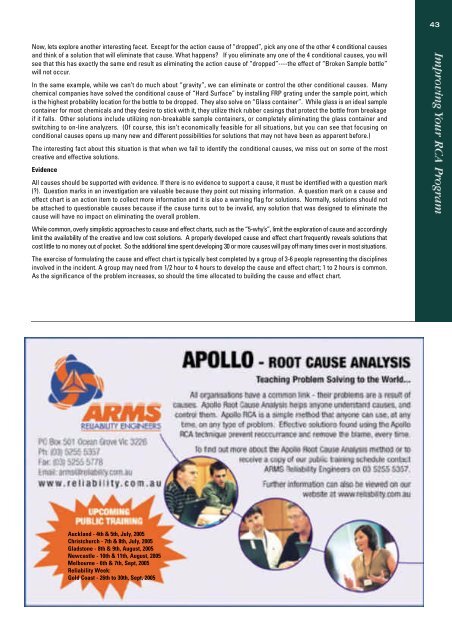August 2005 - Library
August 2005 - Library
August 2005 - Library
Create successful ePaper yourself
Turn your PDF publications into a flip-book with our unique Google optimized e-Paper software.
N o w, lets explore another interesting facet. Except for the action cause of “dropped”, pick any one of the other 4 conditional causes<br />
and think of a solution that will eliminate that cause. What happens? If you eliminate any one of the 4 conditional causes, you will<br />
see that this has exactly the same end result as eliminating the action cause of “dropped”----the effect of “Broken Sample bottle”<br />
will not occur.<br />
In the same example, while we can’t do much about “gravity”, we can eliminate or control the other conditional causes. Many<br />
chemical companies have solved the conditional cause of “Hard Surface” by installing FRP grating under the sample point, which<br />
is the highest probability location for the bottle to be dropped. They also solve on “Glass container”. While glass is an ideal sample<br />
container for most chemicals and they desire to stick with it, they utilize thick rubber casings that protect the bottle from breakage<br />
if it falls. Other solutions include utilizing non-breakable sample containers, or completely eliminating the glass container and<br />
switching to on-line analyzers. (Of course, this isn’t economically feasible for all situations, but you can see that focusing on<br />
conditional causes opens up many new and different possibilities for solutions that may not have been as apparent before.)<br />
The interesting fact about this situation is that when we fail to identify the conditional causes, we miss out on some of the most<br />
creative and effective solutions.<br />
Evidence<br />
All causes should be supported with evidence. If there is no evidence to support a cause, it must be identified with a question mark<br />
(?). Question marks in an investigation are valuable because they point out missing information. A question mark on a cause and<br />
effect chart is an action item to collect more information and it is also a warning flag for solutions. Normally, solutions should not<br />
be attached to questionable causes because if the cause turns out to be invalid, any solution that was designed to eliminate the<br />
cause will have no impact on eliminating the overall problem.<br />
While common, overly simplistic approaches to cause and effect charts, such as the “5-why’s”, limit the exploration of cause and accord i n g l y<br />
limit the availability of the creative and low cost solutions. A properly developed cause and effect chart frequently reveals solutions that<br />
cost little to no money out of pocket. So the additional time spent developing 30 or more causes will pay off many times over in most situations.<br />
The exercise of formulating the cause and effect chart is typically best completed by a group of 3-6 people re p resenting the disciplines<br />
involved in the incident. A group may need from 1/2 hour to 4 hours to develop the cause and effect chart; 1 to 2 hours is common.<br />
As the significance of the problem increases, so should the time allocated to building the cause and effect chart.<br />
Auckland - 4th & 5th, July, <strong>2005</strong><br />
Christchurch - 7th & 8th, July, <strong>2005</strong><br />
Gladstone - 8th & 9th, <strong>August</strong>, <strong>2005</strong><br />
Newcastle - 10th & 11th, <strong>August</strong>, <strong>2005</strong><br />
Melbourne - 6th & 7th, Sept, <strong>2005</strong><br />
Reliability Week:<br />
Gold Coast - 26th to 30th, Sept, <strong>2005</strong><br />
43<br />
43
















